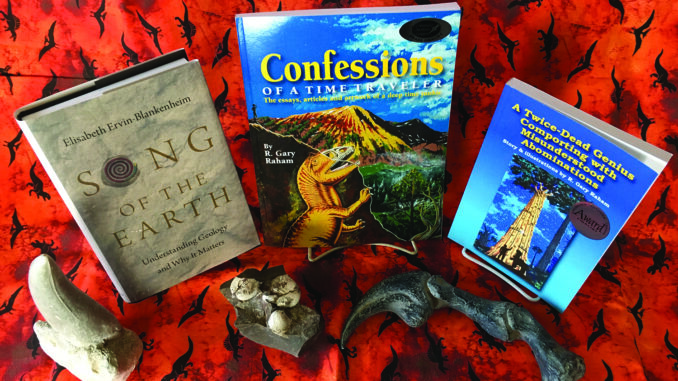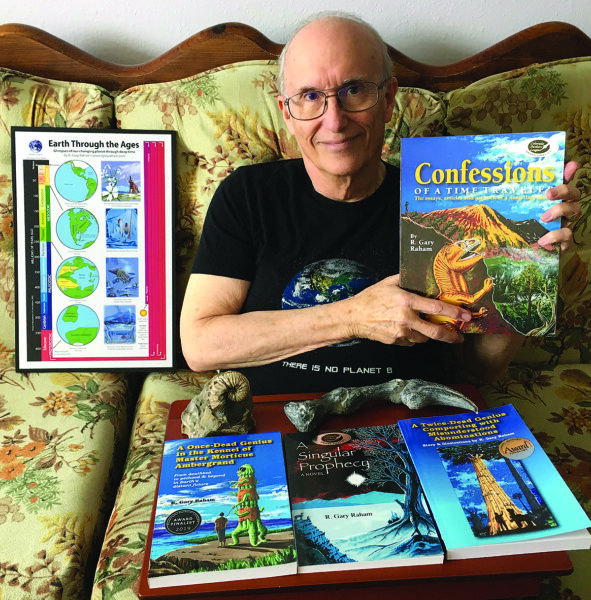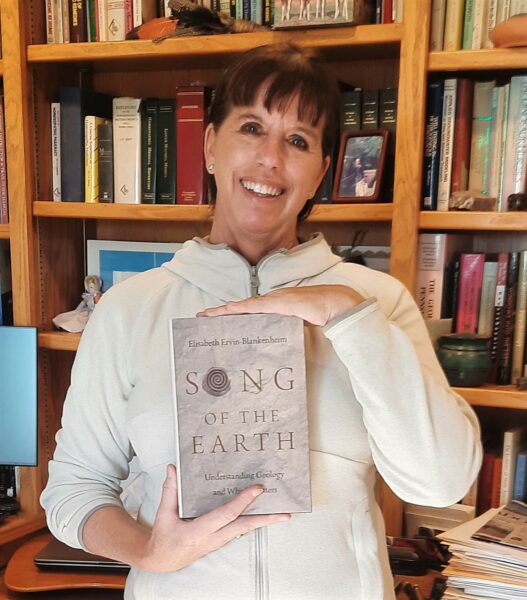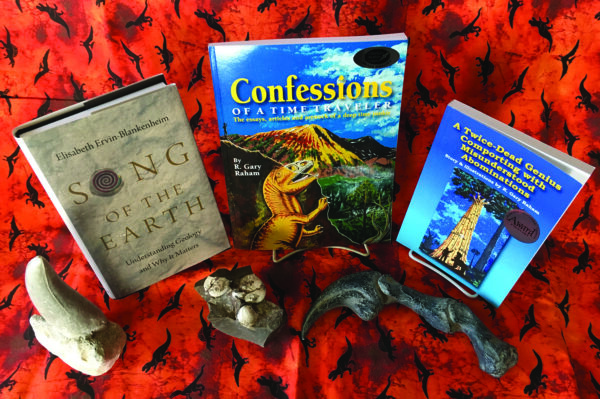
April 23, from 12-4 PM, meet authors Gary Raham and Elizabeth Ervin Blankenheim at Sanderosa Art Gallery in Laporte as they share their Earth Day favorites. Here is a Question and Answer with the authors, about their work.
Question and Answer with Author Gary Raham

What is Earth Through the Ages at Sanderosa Art Gallery all about?
Earth Through the Ages will be a unique and entertaining way to celebrate the planet we all live on. A freshly minted biology teacher out of the University of Michigan in 1969, I remember the first Earth Day April 22, 1970. I was able to share some of my enthusiasm about the interconnectedness of all life on planet Earth with my students. Subsequently, because of a growing interest in paleobiology—the study of mineralized creatures (fossils) that once lived on Earth eons ago—I learned something about how the Earth has changed over time. Nature compels me to draw her portraits and tell her stories. On April 23 at the Sanderosa Art Gallery in LaPorte, I plan on sharing both my writing and illustrations and chatting with others fascinated with nature—her past, present, and even her imagined future. (I write both science fact and science fiction.) I will share the stage with a fantastic geologist/educator, Elisabeth Ervin-Blankenheim. She will help me tell some of Earth’s many stories. From 12-4 p.m. people can come, ask us questions, see real fossils, and enjoy the astounding collection of art (of many kinds) at the gallery.
What are your books about?
One book I’m very proud of is Confessions of a Time Traveler. It’s a compilation of some of my best work from the North Forty News and Colorado Gardener magazine (among others). I plan to read about the fascinating scientist, Lynn Margulis, and her collaboration with James Lovelock to create the “Gaia Hypothesis.” (Gaia is the Greek word for Earth.) Come and learn more!
I also love writing science fiction. In my tongue-in-cheek “Dead Genius” trilogy Gaia even becomes a character in the book. The title of the most recent book—A Twice-Dead Genius Comporting with Misunderstood Abominations—gives you a feel for the tone of the work. If you like reading Kurt Vonnegut’s SF, you’ll probably like mine. AND, you can see the original artwork I created for the covers.
Why do you write both science fact and science fiction?
The first paperback I bought as a ten-year-old was science fiction—an ACE Double novel for anyone old enough to remember those (They cost $0.35). Science fiction helped kick off my interest in science. I think that can be true for generations to come. Science uncovers nature’s secrets. SF writers try to anticipate what might happen next—in an exciting way, of course.
I understand that you and Elisabeth Ervin-Blankenheim, the other author at the event, have worked together. How did that come about?
Elisabeth (Bets) and I both are interested in paleontology. She met me at a WIPS symposium where some of my art was on display. Later, when she was writing her book, she remembered me. I spent much of the pandemic year of 2020 having great fun drawing illustrations for her book, The Song of Earth, and some prehistoric horses for material she created for her classes. Come see us both on April 23!
Question and Answer with author Elisabeth Ervin Blankenheim

What inspired you to write Song of the Earth?
The inspiration for Song of the Earth was my environmental geology students at Front Range Community College, Larimer Campus. Many of them are non-majors, taking my class for science credit, but they loved learning about geology and wanted to know more as the class ended. So I wrote this book for them and those who want to learn more about the Earth, its history, how it works, and its implications for the future, especially in light of the climate crisis.
What was the best part of writing the book?
I loved doing this book because it shares my passion for geology as an overarching framework through which to see the Earth. Writing it took me back to the foundations of modern geology, from the 17th century Enlightenment in Europe to the 20th-century discovery of Plate Tectonics. Finding and reading the original papers and retracing how early scientists figured out the basic tenets of geology was exhilarating. The process brought me back to the reasons I love geology.
What do you most want students to take away from your classes?
After completing my classes, I want my students to understand how science works overall and how geology, specifically, is carried out; the starts and stops, the arguments and doubts, and even the messiness of scientific discovery. It is also essential for students to have the skills to evaluate sources and information for credibility. In addition, I hope to instill in my students an understanding of geology as providing a context for life on the planet. Finally, I encourage my students to take the long view through the biography of the Earth, which gives an appreciation of the planet’s current state and possible solutions going forward.
What other projects are in the works?
I am wrapping up my Ph.D. in Educational Studies, concentrating on scientific and geologic literacy. I plan to publish several articles from my dissertation, one of which is a literature review on how geologic time presently is taught, submitted to the Journal of Geoscience Education. I also will be releasing a toolbox of experiential labs for instructors and professors to give to their students. For example, several labs focus on 3-D printed fossil teeth (of horse ancestors and the fossil shark Megalodon), examining different aspects of the animals over geologic time. Finally, the students wrap up the labs with scientific narrative writing exercises to integrate what they have learned.
More broadly, I am working on a second book called Calamities: Disasters and Catastrophes Across Geologic Time.Calamities focuses on the geologic catastrophes and disasters through the vast biography of the Earth. The book is a bit “tongue in cheek” because, besides extinctions and disasters, geologic processes can and do work slowly over thousands, millions, and billions of years. It is a work of narrative nonfiction written for an adult audience and anyone else who might enjoy engaging tales of devastation in deep time. They are relayed in a storytelling style to take the readers back to the scene of the particular calamity. Stunning color pictures and illustrations (by R. G. Raham) round out and provide another dimension to the stories with parallels drawn from specific disasters with implications for today’s Earth.

Support Northern Colorado Journalism
Show your support for North Forty News by helping us produce more content. It's a kind and simple gesture that will help us continue to bring more content to you.
BONUS - Donors get a link in their receipt to sign up for our once-per-week instant text messaging alert. Get your e-copy of North Forty News the moment it is released!
Click to Donate
